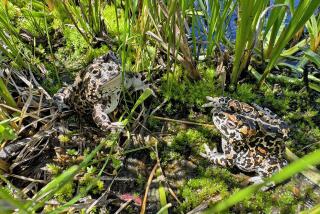Big as Dinner Plates : Toad Invasion Has Australians Hopping
BRISBANE, Australia — Poisonous toads the size of dinner plates have turned the tables on Australian sugar cane farmers who brought them from South America more than 50 years ago to combat a beetle plague.
They’ve become a plague themselves.
Colonies of ugly cane toads have sprung up across Australia’s eastern seaboard and no one knows how to get rid of them.
“Nobody has done much research on them but everybody agrees it’s something we must plan to get rid of,” said Dr. Robert Floyd, of the Department of Entomology at the Commonwealth, Science and Industrial Research Organization, a government-funded body of scientists.
Imported in 1935 to control the gray-backed cane beetle, the cane toad has since been replaced by chemical sprays.
Ecological Disaster
But they have become an ecological disaster because they have no natural predators.
They eat virtually anything that moves--from frogs, snakes and lizards to rodents and insects--and when cornered, they squirt a toxic poison that kills dogs and cats.
Even humans have died from the sticky white substance, which is squirted from neck glands. There are no accurate figures available, but Floyd said he knew of at least six human deaths.
They are now found across 45% of Queensland, but are not restricted to this northern tropical state, which occupies a quarter of the country.
They also have marched southward into New South Wales, and westward to the Northern Territory, Australia’s remotest area.
‘No Stopping Them’
“There’s no stopping them,” Floyd said in an interview. “It’s a nasty animal. It will attack anything.
“We have found that as toad colonies increase, our native fauna--lizards and snakes and small marsupials--decline. For us it’s a major ecological problem.”
The toads, which grow up to nine inches in diameter, are covered in a brownish wart-like skin. They live about 16 years. Adults weigh about a pound and females spawn twice a year, laying 30,000 eggs each time.
A number of proposals have been made to combat the toad, but none proved successful.
Efforts to create an export market for toad skins also failed. U.S. businessman imported 120,000 skins two years ago to make wallets, purses and shoes, but the fashion world ignored them.
In Every Backyard
In Brisbane, a subtropical city of 1.1 million on the east coast, cane toads seem to inhabit every backyard. A new sport, cane-toad busting, is popular among schoolchildren.
“Kids come round all the time with metal spikes asking if they can clear the garden,” said Ann Nakano, a writer. “For two bucks ($1.40), you can’t go wrong.”
More to Read
Sign up for Essential California
The most important California stories and recommendations in your inbox every morning.
You may occasionally receive promotional content from the Los Angeles Times.










